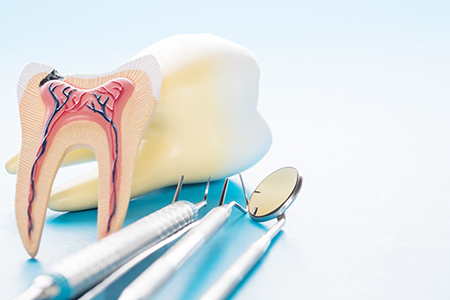
Our Office
Visit Us Online

Facing the prospect of a root canal can feel unsettling, but modern endodontic care is focused on comfort, predictability, and keeping your natural tooth whenever possible. Root canal therapy removes the diseased inner tissues of a tooth, stops infection, and preserves the structure and function that let you eat, speak, and smile with confidence.
At Towne Dental & Orthodontics, we prioritize gentle techniques and clear communication so patients understand why treatment is recommended and what to expect. Our goal is to protect your oral health and return you to normal activity with the fewest possible interruptions.
When a tooth's nerve and blood supply become irreversibly damaged, root canal treatment is the premier option for preserving the natural tooth. Removing the affected tissues and sealing the canals prevents the spread of infection and stabilizes the tooth so it can continue to function for years to come.
Modern instrumentation and filling materials have greatly improved outcomes, making successful root canal therapy a reliable choice for many patients. Choosing to save a natural tooth often means avoiding the additional procedures and alterations that come with extraction and replacement.
Conservative tooth retention supports chewing efficiency and helps maintain the surrounding bone and gum architecture. Keeping your own tooth when feasible is usually the healthiest and most predictable path for long-term oral wellness.

Inside each tooth sits the dental pulp — a small bundle of connective tissue, nerves, and blood vessels that keeps the tooth vital during development. Once the pulp becomes inflamed or infected, it can no longer perform its role and symptoms begin to appear.
Symptoms vary by person and by the stage of disease. Some patients experience sharp, lingering pain or heightened sensitivity to temperature, while others feel a dull ache or notice that a tooth looks darker. In some cases, infection forms at the root tip and causes swelling or pressure in the surrounding gum and bone.
Because symptoms can be inconsistent, routine dental exams and X-rays are important tools for detecting problems before they worsen. Timely diagnosis allows us to recommend the most conservative, effective care for preserving your tooth and protecting your overall oral health.
Persistent discomfort that interferes with sleep or daily activities often indicates a deeper dental issue. Pain that lingers after eating or when lying down can signal pulp inflammation or infection needing professional evaluation.
Strong, lingering sensitivity to hot or cold foods and drinks — beyond the brief twinge typical of minor enamel wear — may reflect nerve irritation inside the tooth that warrants further testing.
Discomfort during chewing or when light pressure is applied can mean the internal tissues are compromised. This symptom often accompanies an infection or structural damage that should be addressed.
A tooth that becomes grayish or darkened after trauma or gradually over time may have internal changes to the pulp. Discoloration is a visible clue that a deeper problem could exist beneath the enamel.
Any break in a tooth's structure can expose the deeper tissues to bacteria, increasing the risk of pulp injury or infection. Even small fractures can progress and require endodontic treatment to save the tooth.
Swelling of the gums or a recurring pimple-like bump on the gum margin suggests an abscess or chronic infection. These signs need prompt attention to prevent more serious complications.
Infection that affects the supporting bone can cause a tooth to feel mobile. Root canal therapy can halt the infectious process and allow the tissues to heal, stabilizing the tooth over time.

Delaying evaluation or treatment when symptoms arise raises the risk of spreading infection and more extensive damage. An untreated pulp infection can extend into the jawbone, adjacent teeth, and, in rare cases, affect systemic health.
Even teeth that are not currently painful can show radiographic signs of trouble, such as changes around the root tip. Catching these issues early allows for less invasive treatment and a higher likelihood of a successful, long-lasting outcome.
Communicating changes in your mouth — new pain, swelling, or altered tooth color — helps your dental team act quickly. Timely root canal therapy often prevents the need for extraction and the restorative work that follows.
Root canal therapy removes the inflamed or infected pulp, cleans and shapes the internal canal spaces, and seals them to prevent recontamination. Advances in imaging and instruments make these steps more precise and comfortable than in the past.
Procedures are performed with effective local anesthesia so most patients feel little to no discomfort during treatment. When anxiety is a concern, a variety of calming measures are available and can be discussed with your provider to tailor the experience to your needs.
Some treatments are completed in a single visit; others may require two appointments depending on the tooth's anatomy and whether an active infection is present. Once the canals are sealed, the tooth is typically restored with a permanent filling or crown to rebuild strength and function.

After treatment, mild soreness is common as the surrounding tissues heal. Over-the-counter pain relievers are often sufficient, and any prescribed medications should be taken exactly as directed. Normal sensation returns as anesthesia wears off, but you should avoid chewing on the treated tooth until it is fully restored.
A tooth that has undergone root canal therapy is no longer alive in the same way as before, so it benefits from a protective restoration — often a crown — to prevent fracture and restore full chewing strength. Completing this restoration in a timely manner helps ensure the long-term success of the treatment.
Good daily oral hygiene and regular dental checkups are essential to monitor the treated tooth and the surrounding tissues. With attentive care, a properly treated tooth can provide reliable service for many years, often for a lifetime.
You may experience temporary numbness after the appointment. Avoid hot foods and careful chewing until feeling returns, and protect soft tissues to prevent accidental injury.
Some soreness is normal as inflammation settles. This typically diminishes within days; if discomfort worsens or persists, contact your dental team for reassessment.
If antibiotics are prescribed to address infection, complete the full course as directed even if symptoms improve. This helps ensure thorough resolution.
A tooth with a temporary filling should be handled gently until the final restoration is placed. Avoid hard or sticky foods and chew on the opposite side when possible.
Consistent brushing and flossing support healing and prevent new problems. Maintaining overall oral hygiene helps protect both the treated tooth and adjacent teeth.
Completing the permanent restoration — typically a crown or onlay — rebuilds the tooth’s structural integrity and lets you return to full function confidently.
With careful follow-up and routine dental care, a tooth treated with root canal therapy can remain a stable, functional part of your mouth for many years. Our team is committed to guiding you through each step of treatment and recovery.
If you would like more information about root canal treatment or want to discuss options for preserving a troubled tooth, please contact us for assistance and to schedule an evaluation.
A root canal procedure is the best way to save a tooth that has been damaged by decay or injury and preserve your natural smile. The alternative is an extraction and treatment to replace the tooth. While at times a tooth is non-restorable and an extraction is the only option, when possible, it’s best to try and save your natural tooth. With proper care, a tooth with root canal therapy can serve your smile well for many years to come.
Despite lingering myths from before the age of modern dental anesthesia and technology, having a root canal procedure today is as routine and comfortable as visiting the dentist for a filling. While the procedure is performed under local anesthesia with your tooth completely numbed, we can also discuss options in dental sedation.
Whether the symptoms of a dental infection subside after a course of antibiotics, a draining abscess provides you with some temporary pain relief, or a tooth with radiographic evidence of pathology has not yet developed symptoms, it’s essential, before an infection worsens or occurs, to have a root canal procedure performed. In this way, the tooth can be disinfected, filled, and sealed to protect your health and avoid further problems.
If you have sustained a dental injury, have a toothache, jaw pain, swelling, or are experiencing any other unusual and uncomfortable oral symptoms, contact our office immediately for care. Dental problems that have not been evaluated and treated can significantly worsen, producing more severe damage and consequences for the involved teeth, your oral health, and even your overall wellbeing. Once you get in touch with our office, our friendly and compassionate office team will get you in for care at your earliest convenience.
While some root canal procedures can be completed in one visit, others may involve 2 or 3 appointments. How long it takes depends on various factors, including active infection, the number of canals in the tooth, and the tooth’s location or anatomy.
With a success rate that exceeds 95%, root canal therapy remains the most effective procedure to save a tooth in which the inner vital tissues have been damaged. However, as with all healthcare procedures, there are a small percentage of cases where the teeth become symptomatic a second time. The good news is that many of these teeth can still be saved with root canal retreatment or a minor surgical procedure known as an apicoectomy.
The best ways to maintain a tooth with root canal therapy are to get the proper restoration required to rebuild and protect the tooth, maintain proper oral hygiene, and schedule appointments for routine dental checkups and care.
Saving a tooth with root canal therapy is a wise investment that, in the long run, is typically less costly and invasive than having the tooth extracted and replaced with a fixed bridge or implant. As far as the exact cost of care, it can vary depending on which tooth is being treated. Many dental insurance plans provide coverage for root canal therapy. At the office of Towne Dental & Orthodontics, we do our best to optimize your dental benefits and minimize your out-of-pocket expenses. Our staff will answer all your questions about the cost of care and discuss all your payment options.
At the office of Towne Dental & Orthodontics, we use the latest technology and most effective methods of care to provide precise and gentle care. Our reputation for excellence is based upon a consistent record of achieving successful treatment outcomes while providing prompt, stress-free, and convenient treatment for every type of dental need.
Root canal therapy, also called endodontic treatment, removes damaged or infected pulp from inside a tooth to stop infection and preserve natural function. The procedure is recommended when the pulp becomes inflamed or necrotic due to deep decay, trauma, or repeated restorative work. Early intervention typically offers the best chance to save the tooth and prevent spread of infection.
At Towne Dental & Orthodontics in Waller, TX, the goal of treatment is to relieve pain, eradicate infection, and retain the tooth whenever feasible. A clinical exam and radiographs help determine whether root canal therapy is the most appropriate, conservative option for long-term oral health. When recommended, the procedure is planned to restore comfort and chewing function with minimal disruption to daily life.
Root canal treatment preserves the natural tooth by removing the diseased inner tissues, cleaning and shaping the root canal system, and sealing the space to prevent recontamination. By retaining the tooth structure, the procedure helps maintain proper chewing function, normal bite relationships, and the bone that supports adjacent teeth. Saving the natural tooth often avoids the need for more invasive replacement options that can affect neighboring teeth.
Following canal sealing, the tooth is typically restored with a filling or crown to rebuild strength and protect against fracture. This restoration restores full function and distributes biting forces properly, reducing the risk of future breakdown. With appropriate restoration and routine care, a treated tooth can remain functional for many years.
Common warning signs include persistent or severe tooth pain, lingering sensitivity to hot or cold, and soreness when biting or touching the tooth. Other indicators can be tooth discoloration, visible cracks or chips, gum swelling or drainage near the tooth, and a feeling that the tooth is loose. Symptoms may vary widely, and some infections cause minimal pain while still producing radiographic changes.
Because symptoms can be inconsistent, routine dental exams and X-rays are important for catching problems early before they worsen. If you notice new pain, swelling, or a change in tooth color, notify your dental team promptly for evaluation. Timely diagnosis increases the likelihood of successful, conservative treatment and helps protect overall oral health.
Modern root canal therapy begins with effective local anesthesia to ensure comfort, followed by access into the tooth to remove inflamed or infected pulp tissue. The canals are then cleaned, shaped with precision instruments, and irrigated to remove debris and bacteria before being filled and sealed with biocompatible materials. Advanced imaging and instruments improve accuracy and reduce treatment time compared with older techniques.
Some cases are completed in a single visit while others may require two appointments depending on anatomy and infection status. Temporary restorations protect the tooth between visits when necessary, and a permanent filling or crown is placed after the canals are sealed. Throughout the process, the dental team will explain each step and discuss any options to address anxiety or enhance comfort.
Most patients experience little to no pain during a modern root canal because of effective local anesthesia and gentle technique. Mild soreness or pressure is common for a few days after treatment as surrounding tissues heal, and this is usually manageable with over-the-counter pain relievers and home care. If pain intensifies or persists beyond the expected healing period, contact your dental team for reassessment.
The practice offers options to help anxious patients feel more relaxed during treatment, and any concerns about comfort can be discussed before the appointment. Good communication allows the team to tailor the experience to each patient’s needs. Prompt follow-up ensures complications are addressed quickly and healing proceeds as expected.
Recovery after a root canal typically involves a few days of mild tenderness or sensitivity as the tissues resolve inflammation. Most patients resume normal activities immediately, though it is wise to avoid chewing on the treated tooth until the final restoration is in place to prevent damage. Any prescribed medications should be taken exactly as directed, and over-the-counter analgesics usually control routine postoperative discomfort.
Follow-up visits allow the dental team to monitor healing and complete permanent restoration, which is important for long-term success. Maintain diligent oral hygiene and attend regular checkups to protect the treated tooth and surrounding tissues. If swelling, increased pain, or new symptoms develop, contact the office promptly for evaluation.
Many teeth receive a protective restoration, often a crown, after root canal therapy to rebuild structural integrity and resist fracture. Teeth that have extensive decay or large restorations prior to treatment are at higher risk of breaking and therefore commonly benefit from a crown. Posterior teeth that endure strong biting forces are frequently restored with crowns for long-term durability.
The type and timing of the restoration depend on the tooth’s remaining structure and functional demands, and your dentist will recommend the most appropriate option. Completing the permanent restoration in a timely manner supports the success of the root canal and helps the tooth function normally for years. Regular checkups ensure the restoration remains sound and the tooth stays healthy.
In many cases, a tooth with a significant infection or abscess can still be saved with root canal therapy combined with appropriate antibiotics or drainage when indicated. The treatment focuses on eliminating infection within the canal system and allowing surrounding bone and tissues to heal over time. Success depends on factors such as the extent of infection, the tooth’s anatomy, and the quality of the final restoration.
When advanced damage or structural loss makes preservation impractical, the dental team will discuss alternatives and next steps. However, root canal therapy often offers a predictable path to remove infection and retain the natural tooth. Radiographic monitoring and clinical follow-up help confirm healing and guide any additional care if needed.
Preventive care is the most effective way to reduce the risk of needing a root canal: maintain consistent brushing and flossing, attend regular dental examinations, and address cavities or cracks early. Protective measures such as mouthguards for sports and prompt repair of broken teeth limit trauma that can expose the pulp to bacteria. Routine X-rays and clinical exams allow your dental team to detect and treat issues before they progress to pulp involvement.
Good overall health and management of conditions that affect oral tissues also support dental resilience. If you experience any new pain, swelling, or sensitivity, schedule an evaluation rather than waiting for symptoms to worsen. Early action preserves options and often allows for simpler, more conservative care.
The decision between root canal therapy and extraction is based on clinical findings, radiographic evidence, the tooth’s restorability, the patient’s overall oral health, and long-term functional goals. Root canal therapy is typically recommended when the tooth can be predictably restored and preserved, allowing the patient to maintain natural chewing function and support for adjacent teeth. Extraction may be considered when structural damage is severe, the tooth cannot be adequately restored, or other local or systemic factors limit the chance of success.
The team at Towne Dental & Orthodontics evaluates each case individually, explaining the pros and cons of all viable options and the expected outcomes for long-term oral health. When extraction is the chosen path, restorative alternatives to replace the missing tooth are discussed to protect chewing ability and bone health. Informed decision-making with your dental provider ensures treatment aligns with your goals and the best possible prognosis.